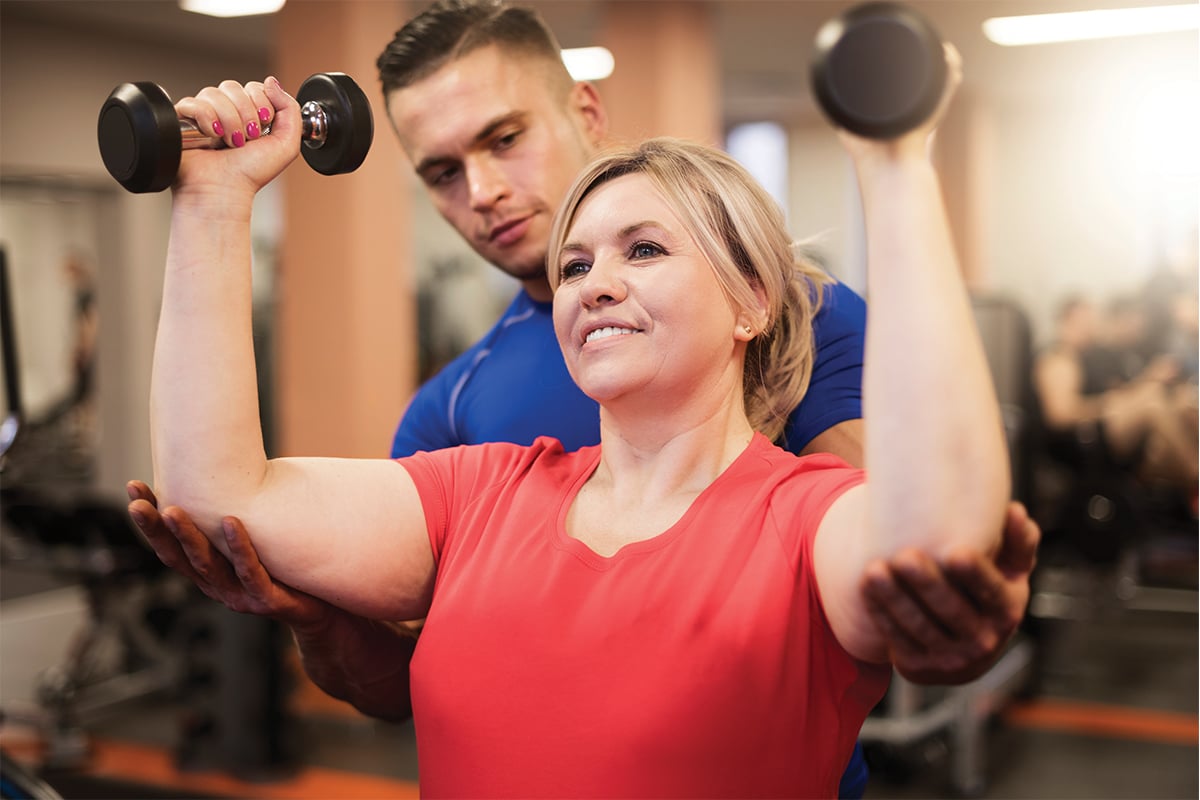Originally published in the spring 2017 issue of American Fitness Magazine.
Uplifting news: Just 4 weeks of resistance training can decrease body fat and waist size. Resistance training and the 2nd phase of the OPT™ model is a must for any weight loss program.
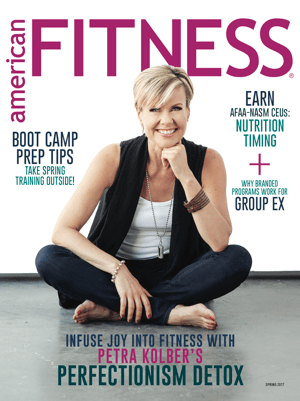 Everyone needs at least some strength work in their training program, regardless of their goals. Increasing strength helps to create strong bones, decreases the chance of common injuries, improves quality of life and helps to control weight by increasing calories burned daily. For the two-thirds of the U.S. population who want to lose weight this spring, strength training is a key component of long-term success. This article briefly explains Phase 2 of the OPT™ model that is used in the NASM Certified Personal Trainer program and how it contributes to a leaner look, while also improving strength, work capacity and joint stabilization.
Everyone needs at least some strength work in their training program, regardless of their goals. Increasing strength helps to create strong bones, decreases the chance of common injuries, improves quality of life and helps to control weight by increasing calories burned daily. For the two-thirds of the U.S. population who want to lose weight this spring, strength training is a key component of long-term success. This article briefly explains Phase 2 of the OPT™ model that is used in the NASM Certified Personal Trainer program and how it contributes to a leaner look, while also improving strength, work capacity and joint stabilization.
Download the spring 2017 issue of American Fitness Magazine.
Shifting to OPT Phase 2
We've written on NASM's OPT model, specifically how Phase 1 (Stabilization) establishes a solid foundation for the client to safely progress. The next phases focus on developing strength.
Phase 2 of the OPT model is Strength Endurance training, a bridge from lower-intensity stabilization training to more intensive strength training. Phase 2 recommends combining two exercises back-to-back in a superset. The first exercise is more traditional, focused on increasing strength in a stable environment. Therefore, an individual would lift more weight (70-80% 1-repetition maximum) and follow up with a similar exercise at a lower intensity (50-70% 1-RM) in an unstable environment.
The first exercise in the superset could be a bench press for the chest, a seated cable row for the back, or a squat for the legs. These exercises demand more from the larger muscles, thus helping to increase strength. The second exercise in the sequence uses the same muscle groups but incorporates stabilization in a less stable (but controllable) environment.
For the chest superset, a bench press can lead directly into a standing cable press or a pushup. These still use the chest muscles while also engaging the muscles around the legs, hips and core. Similarly, for the legs, a barbell squat can precede a single-leg squat or a lunge to balance.
The nature of supersets makes Phase 2 a lot of fun, while incredibly demanding and effective. These are some of the benefits of Phase 2:
- Increased lean body mass (Clark et al. 2012)
- Increased prime mover strength
- Enhanced joint stabilization
- Improved overall work capacity
Let's discuss each of these in more detail.
How Does Phase 2 Increase Lean Body Mass?
In essence, Phase 2 increases lean body mass in these key ways:
- Adding small amounts of muscle
- Increasing resting metabolic rate
- Boosting metabolism after a workout, thus burning more calories for several hours. Which you can measure through metabolic equivalents.
Here are proven reasons Phase 2 will help clients meet weight loss goals:
Muscle looks leaner
First, understand that lifting weights does not make a person "bulky." Getting bulky reflects three specific factors: calories, hormone profiles and hypertrophy-specific training. Calories matter because a human must have lots of energy coming in to increase size. Hormone profiles play a role, as we know more testosterone is associated with more muscle mass.
Finally, resistance training for muscular development/hypertrophy must be very specific (this is Phase 3 in the OPT model), using specific ranges of intensities, rest periods and proper exercises. Even then, an exerciser may expect to gain somewhere between 0.25-0.50 pounds of muscle every several weeks.
Staron et al. (1985) found no significant increases in muscle size for up to 8 weeks of heavy-resistance training. Therefore, those who specifically do not want to get bulky can rest assured that Phase 2 won't do it. Resistance training does add small amounts of muscle, and more over time for those who decide to train specifically for muscular development. When the body contains slightly more muscle, it doesn't look large. In fact, time and time again, those who add weight training into weight loss programs say they look and feel leaner.
A study with 29 women found that 4 weeks of resistance training decreased body fat, decreased waist and hip circumference and improved overall health (Jee & Kim 2016). Fat takes up more space per pound than muscle, so more muscle is a leaner look.
Muscle burns more calories than fat
A body with more muscle also burns more calories than a body with more fat. Studies have found that resistance training can increase resting metabolic rate and daily energy expenditure, assisting in weight loss (Kirk et al. 2009; Washburn et al. 2012). This works simply by increasing fat-free mass, usually called muscle mass.
This notion is supported by research which found that 9 months of resistance training increased resting metabolic rate by an average of 5% or about 158 calories per day (Aristizabal et al. 2015).
That is more than 50,000 calories per year! Therefore, the superset design of Phase 2 allows the client to increase small amounts of muscle mass while expending large amounts of calories, thus becoming a lean muscle mass machine.
Read also: Weight Lifting for Weight Loss
Resistance training boosts post-exercise calorie burn
Finally, resistance training that increases lean body mass elevates excess post-exercise oxygen consumption, or EPOC. The body's need for oxygen often remains elevated for several hours after a training session, which in turn elevates the metabolism (Gaesser & Brooks 1984). This hypermetabolic period is thought to play a key role in managing body weight because the body needs to keep burning calories to return everything to a normal state.
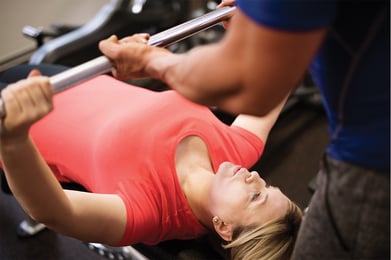 When Haddock & Wilkin (2006) compared endurance training and weight training, they found that weight training required more recovery energy and longer EPOC, therefore burning more calories. Another study comparing high- and low-intensity resistance training found the high-intensity group had increased EPOC for up to 24 hours after training-again, burning more calories (Paoli et al. 2012).
When Haddock & Wilkin (2006) compared endurance training and weight training, they found that weight training required more recovery energy and longer EPOC, therefore burning more calories. Another study comparing high- and low-intensity resistance training found the high-intensity group had increased EPOC for up to 24 hours after training-again, burning more calories (Paoli et al. 2012).
If you want to do quick calorie calculations for your clients, follow this link for a great tool.
How Does Phase 2 Increase Strength?
Strength reflects many factors: the nervous system, the size of the muscle, the types of fibers, the joints involved, how quickly the muscle can contract, and the body type of the individual. Weier and colleagues (2012) found that the initial weeks of strength training change the brain's motor cortex, which sends nerve impulses that cause voluntary activity. This research also suggests that these changes occurred only after repetitive stimulation. Thus, strength training exercises must be repeated.
This explains why someone who looks small can be incredibly strong: Their nervous system has learned to recruit more motor units very quickly. In essence, that is the definition of strength: the "ability of the nervous system to provide internal tension and exert force against an external resistance" (McGill & Montel 2017). This also tells us exercisers will see small increases in strength when they begin any form of resistance training, but unless they progressively overload-putting more weight on the bar-strength increases will quickly plateau.
Phase 2 offers a slow, safe progression of intensity by gradually increasing the weight lifted over 4-6 weeks and keeping the much-needed stabilization exercises.
How Does Phase 2 Enhance Joint Stabilization?
Joints are not inherently stable: They're stabilized by ligaments, tendons and muscles. Most stabilizing muscles are smaller, quicker and respond better to lower intensities. Consider the rotator cuff of the shoulder: Muscles here should contract rapidly, before the larger muscles of the deltoid and pectorals, to ideally stabilize the head of the humerus in the shoulder blade. Phase 1 accomplishes much of the training of these stabilizers.
Phase 2 progresses this training by first fatiguing the prime mover. In many cases, the larger muscles will overwork the smaller ones. Therefore, performing a higher-intensity lift first causes the larger muscles to fatigue, "forcing" the stabilizers to continue stabilizing. This further increases the body's ability to maintain postural stabilization and to stabilize joints during movement (Clark et al. 2012).
How Does Phase 2 Increase Work Capacity?
Work capacity is simply the total work an exerciser can perform. Phase 2 increases work capacity because the exercises must be done for long times with no rest. For discussion's sake, consider a workout involving the chest, back and legs. NASM suggests following a process called "vertical loading" to save time by eliminating unnecessary rest. The first exercise uses a controlled pace (~4 seconds/rep) for about 10 repetitions, followed by a slower second exercise (~7 seconds/rep) for about 12-15 repetitions. Simple math suggests this is about
2 minutes, 25 seconds of work with no breaks-just for one body part.
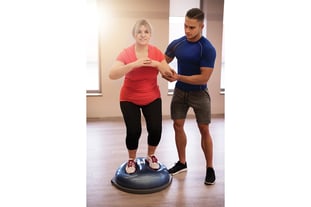 When vertical loading, the individual does 1 set of chest, 1 set of back and finally 1 set of legs, then repeats the cycle in the sets that follow. After the first set, the client has been "doing work" for almost 8 minutes nonstop. After a small break, the next 8-minute set begins. This demanding process quickly encourages the body to increase aerobic and anaerobic capacity to keep up.
When vertical loading, the individual does 1 set of chest, 1 set of back and finally 1 set of legs, then repeats the cycle in the sets that follow. After the first set, the client has been "doing work" for almost 8 minutes nonstop. After a small break, the next 8-minute set begins. This demanding process quickly encourages the body to increase aerobic and anaerobic capacity to keep up.
Performing exercises in an unstable environment improves neuromuscular efficiency, stabilization and functional strength.
Look Better, Feel Better, Move Better!
All of these benefits combine to prepare the client to continue progressing through the OPT model, reaching any goal they have. After Phase 2, exercisers may like the idea of more muscle and progress to Phase 3: Hypertrophy. Or maybe they jump to Phase 5: Power, for the next level of intense training.
The bottom line is that strength is fundamental to all great training programs, and Phase 2 is a safe and effective way to build strength. With summer approaching and many wanting to get the "lean" look, be sure to consider adding strength endurance training to the program. At completion, your client will look better; feel better; have better endurance, stamina and strength; and be ready for the next training challenge!
Strengthen Your Base of Knowledge
Good science is the key to helping clients achieve their goals. At times, making sense of the science can be a little frustrating and confusing for clients and fitness professionals alike. That's why the NASM Certified Personal Trainer program presents complex science concepts in real-world scenarios, and it breaks down the information into easy-to-understand, easy-to-digest segments.
Here is just one example of the applied science found in Module 12: Applying Strength in the NASM-CPT program.
Finding a Healthy Balance
Clients may view resistance training solely as a muscle-building activity. However, the Strength Level of the NASM OPT model emphasizes the importance of a training program being well-rounded. This means combining strength work with flexibility, core and balance training protocols.
A look at balance training, for example: According to the NASM-CPT text NASM Essentials of Personal Fitness Training (McGill & Montel 2017), "Research has shown that balance training improves sports performance and reduces sport-related injuries, and restores proprioception and neuromuscular function compromised by injuries (Bernier & Perrin 1998; Elis & Rosenbaum 2001; Hertel et al. 2006; Hewett, Meyer & Ford 2005; McKeon & Hertel 2008; Mansfield et al. 2015; Lesinski et al. 2015; Zech et al. 2009)."
In the Strength Level of the NASM OPT model, clients are progressed from stabilization exercises to ones that require "dynamic control in the mid-ROM, with isometric stabilization at the end ROM." Phase 2, which is discussed in this article, should include balance strength exercises during the movement prep part of the workout, aiming for 1-3 such exercises, up to 4 times per week (2-3 sets of 8-12 reps). Some examples include the following:
- Single-leg squat
- Single-leg squat with touch
- Single-leg Romanian deadlift
- Single-leg lift and chop
- Multiplanar lunge to balance
In the NASM-CPT program, personal trainers will gain a deeper understanding of concepts like this, as well as instruction on the correct performance of the exercises, while being exposed to the science from which they originate. As part of this 16-module course, fitness professionals will have access to online reading material, an exercise library, predesigned workouts, and concise videos including lectures, introductory concepts, and exercise techniques. Users can also access case studies, learning activities, quizzes and practice exams.
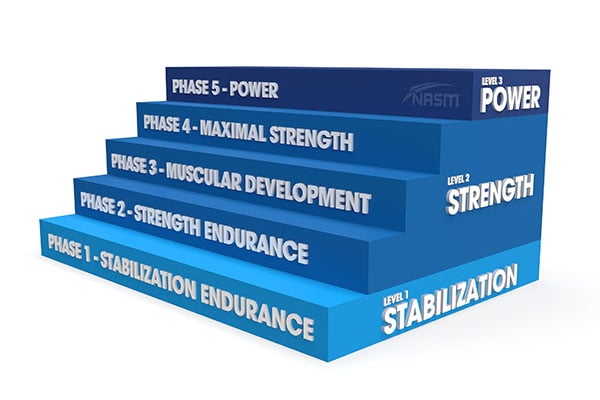
The systematic and integrative OPT™ model progresses clients safely and effectively.
Sample Superset Workout
Start with a Phase 2 warm-up with foam rolling and active stretching followed by core, balance and plyometric training with 2-3 sets of 10 reps. In the supersets, below, the first exercise should hit 80% intensity for 8 reps with a tempo, in seconds, of 2/0/2 (eccentric/isometric hold/concentric). The second exercise is done at body weight or 50% intensity for 12 reps with a 4/2/1 tempo.
Total Body Superset
SET 1: Squat to press
1A: Stand, feet hip-width apart, elbows bent, holding a dumbbell in each hand at shoulder height.
1B: Keeping chest upright, bend knees and squat until thighs are parallel to the floor.
1C: Stand while pressing dumbbells overhead until arms are straight. Slowly return to starting position. That's 1 rep.
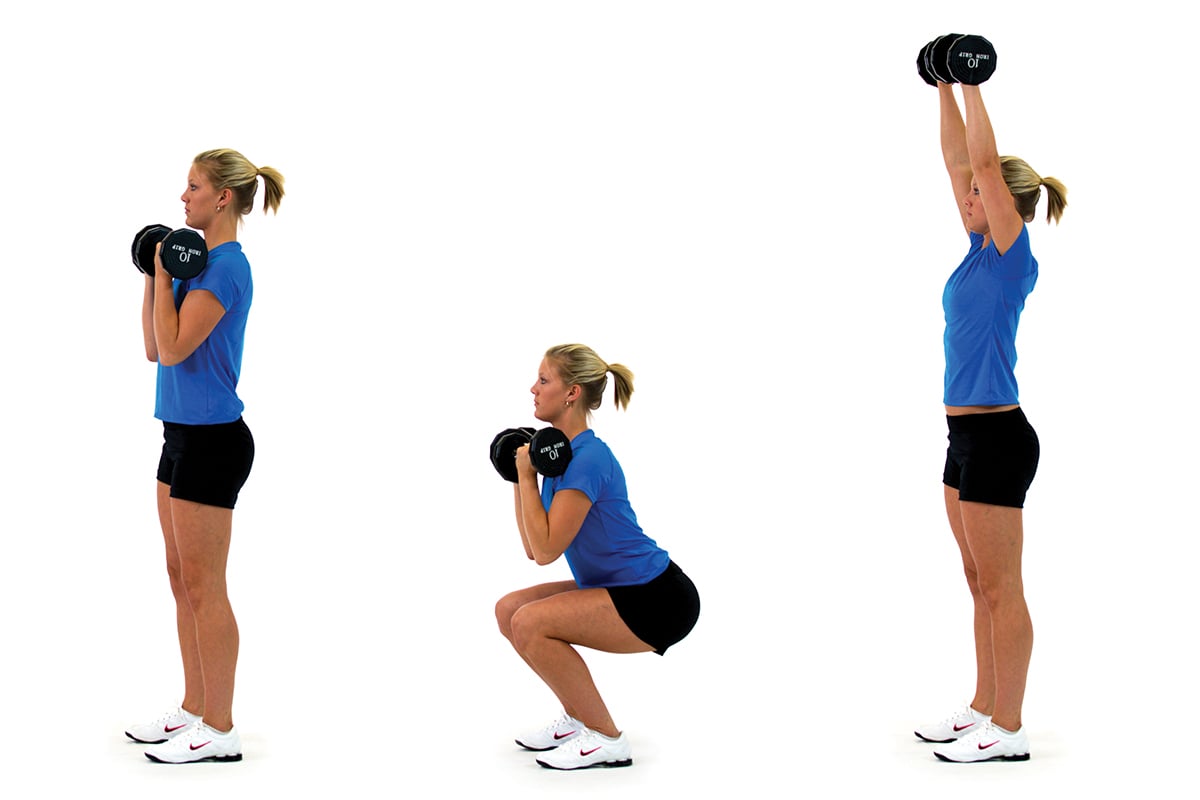
SET 2: Single-leg dumbbell scaption
2A: Stand, feet together, arms straight, holding a dumbbell in each hand. Lift one leg, keeping it beside the other leg.
2B: Keeping thumbs pointed up, slowly raise arms to the front at about a 45-degree angle. Slowly lower to starting position. That's 1 rep. Alternate the balance leg for each set.
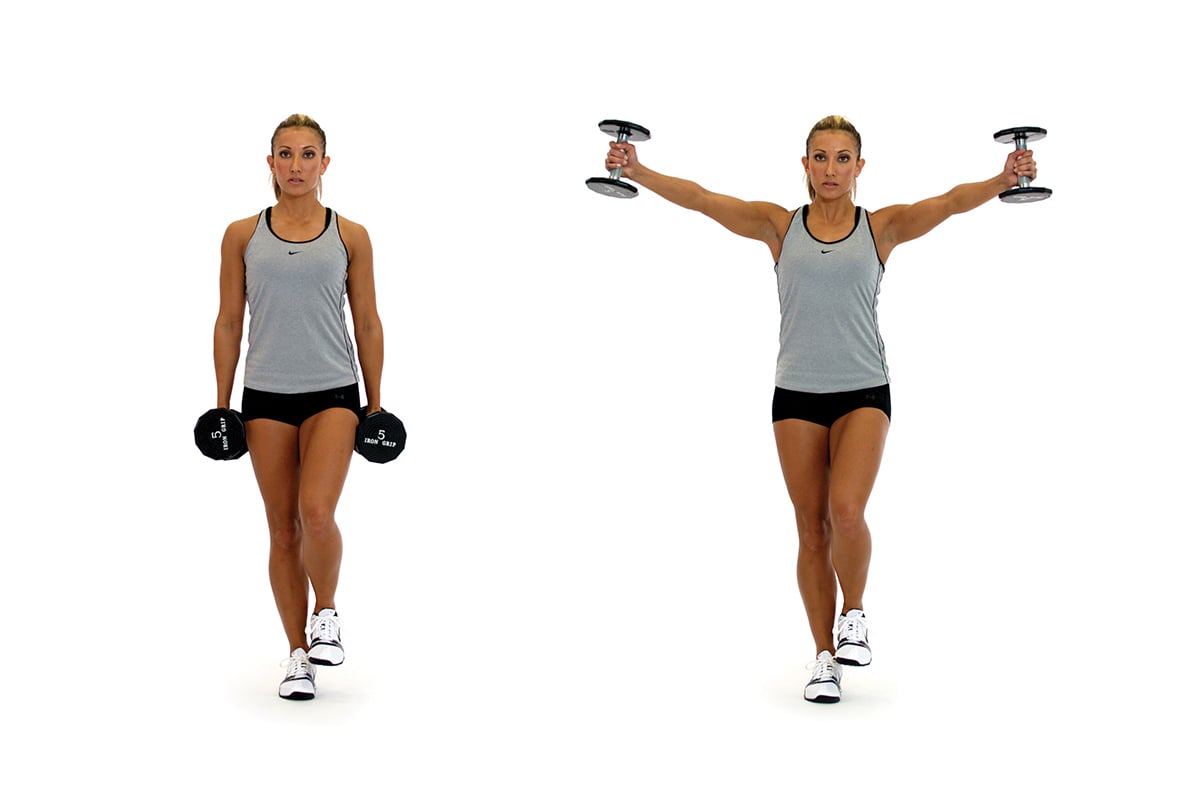
Back Superset
SET 1: Seated cable row
1A: Sit facing a cable machine, feet on the floor and toes pointing forward. Hold the cable grips with arms extended.
1B: Bend elbows and pull back on grips, drawing shoulder blades together and down. Slowly return to starting position. That's 1 rep.
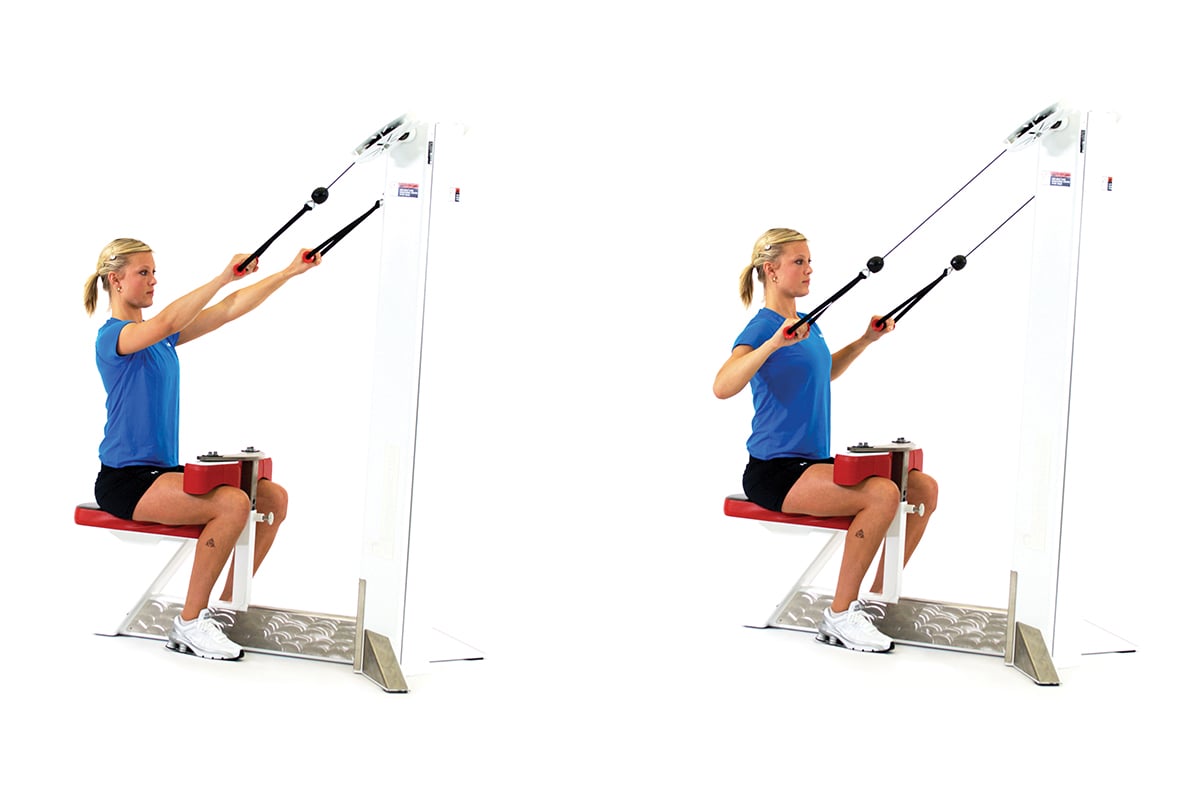
SET 2: Single-leg, single-arm cable row
2A: Stand facing a cable machine with cable grip in one hand, palm facing floor. Lift the leg on the same side, keeping it beside the other leg.
2B: Bend elbow to pull grip toward chest. Keep foot raised while slowly returning to starting position. That's 1 rep. Alternate sides for each set.

Chest Superset
SET 1: Bench press
1A: Lay down on a bench, elbows bent, holding a barbell just above the chest. Palms should face the feet and elbows should be directly below wrists.
1B: Press up, raising barbell straight over chest until arms are straight. Slowly lower to starting position. That's 1 rep.
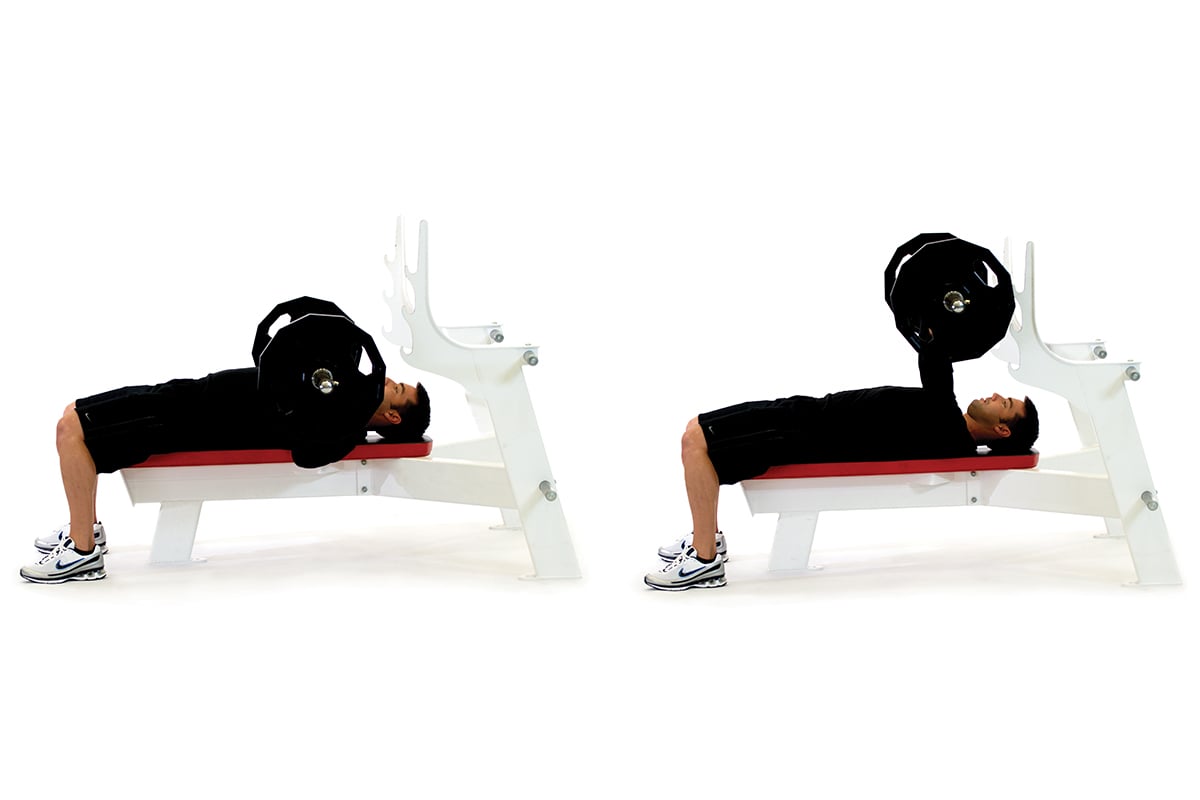
SET 2: Stability ball pushup
2A: Begin with chest and hands on stability ball and feet extended back, balanced on toes. Keep hips and knees in a straight line and engage core.
2B: Press up through palms, maintaining balance while straightening arms.
2C: Extend to full pushup. Slowly lower to starting position. That's 1 rep.
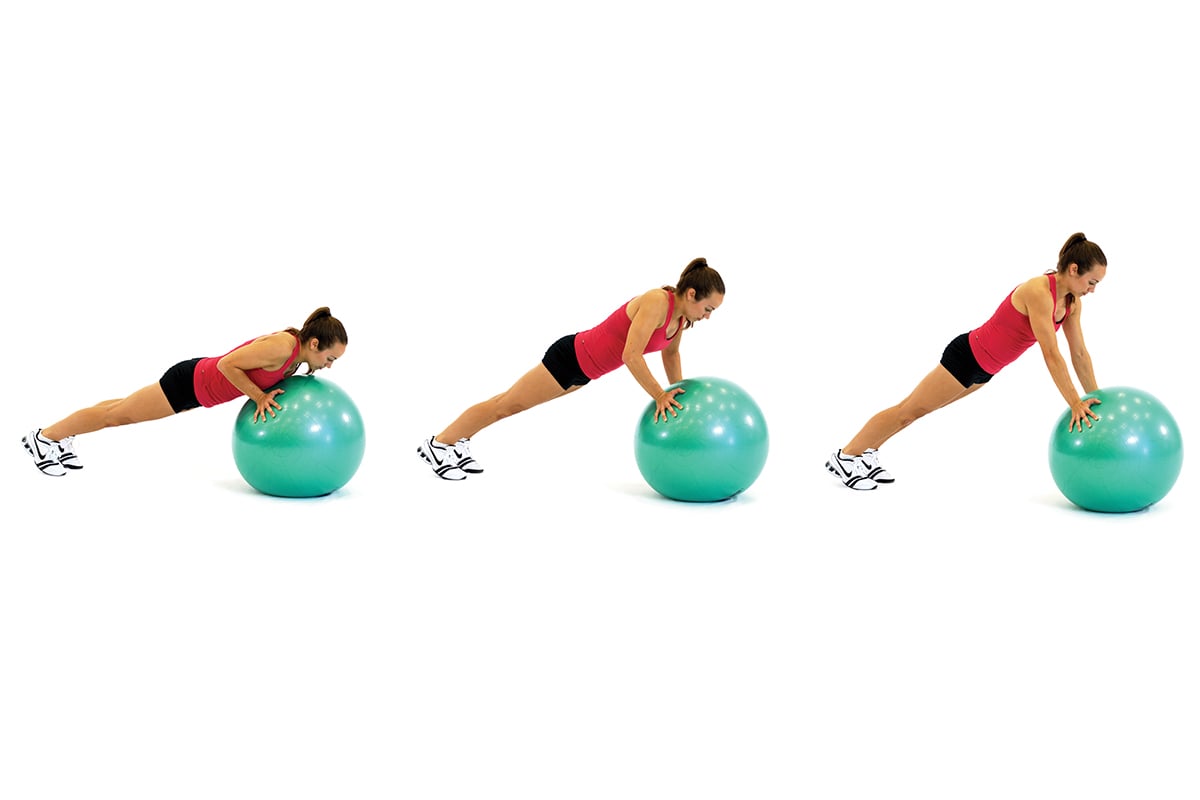
Legs Superset
SET 1: Barbell deadlift
1A: Stand, feet wider than shoulder-width apart, and hold a barbell in front of you, arms extended. Bend knees slightly until weight is mid-thigh. Keep back flat and knees slightly bent.
1B: Bend forward at hips and lower bar to floor, knees bending slightly. Return slowly to starting position, extending hips. That's 1 rep.
See the NASM Exercise Library demonstration on how to do a conventional deadlift.
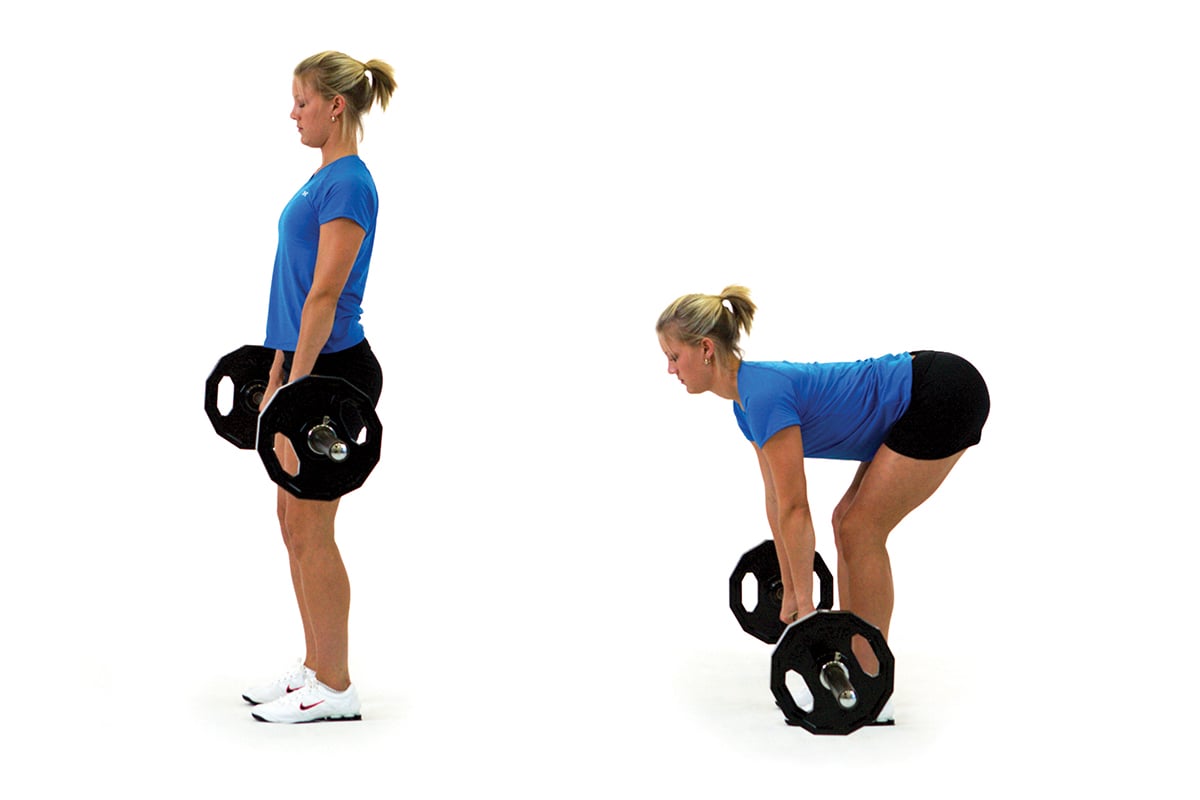
SET 2: Single-leg squat with touch
2A: Stand, feet shoulder-width apart, and toes straight ahead. Lift chest, pull back shoulder blades and engage core. On raised-leg side, keep arm straight; place other hand on hip.
2B: Slowly bend forward to reach fingertips to toes. Slowly return to starting position, engaging core. That's 1 rep.
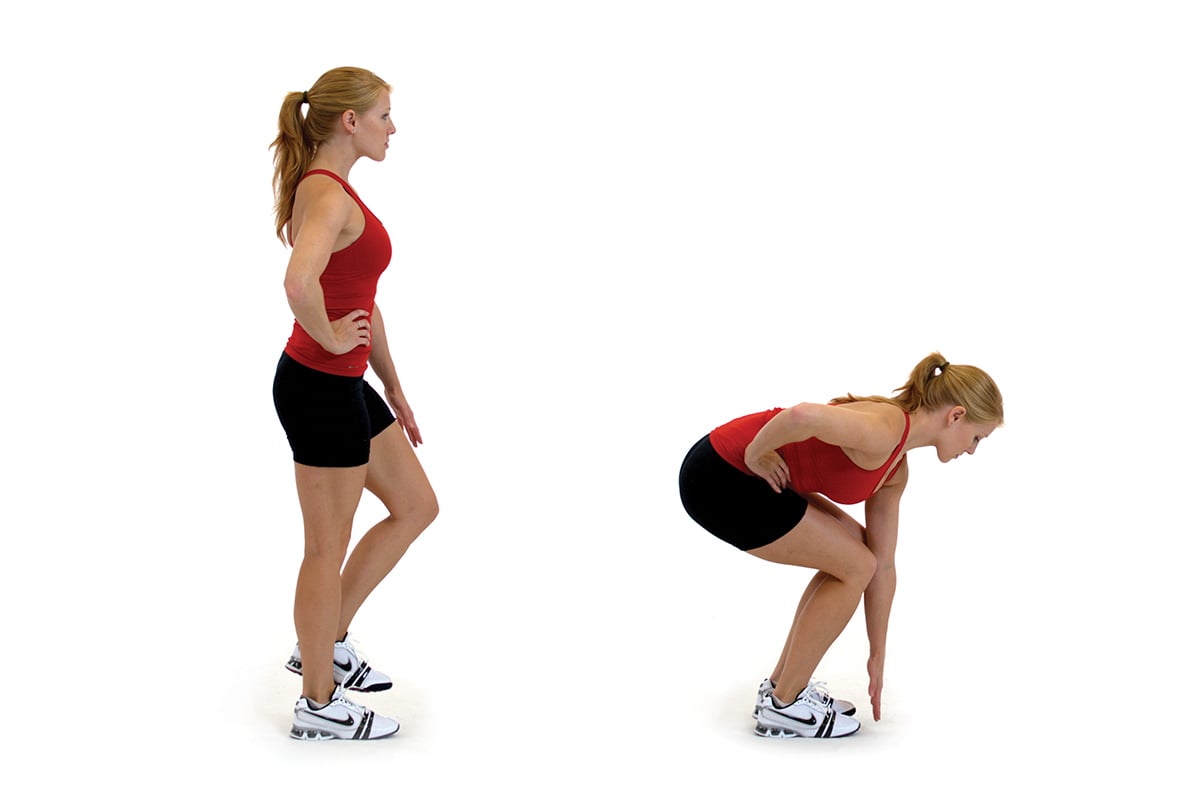
Increasing strength helps build strong bones, decreases the chance of common injuries, improves quality of life and helps control weight by increasing calories burned daily.
A study with 29 women found that 4 weeks of resistance training decreased body fat, decreased waist and hip circumference and improved overall health. Fat takes up more space per pound than muscle, so more muscle is a leaner look.
REFERENCES:
Aristizabal, J.C., et al. 2015. Effect of resistance training on resting metabolic rate and its estimation by a dual-energy X-ray absorptiometry metabolic map. European Journal of Clinical Nutrition, 69 (7), 831-36.
Clark, M.A., Lucett, S.C., & Sutton, B.G. 2012. NASM Essentials of Personal Fitness Training (4th ed.). Philadelphia: Lippincott Williams & Wilkins.
Gaesser, G.A., & Brooks, G.A. 1984. Metabolic bases of excess post-exercise oxygen consumption: A review. Medicine & Science in Sports & Exercise, 16 (1), 29-43.
Haddock, B.L., & Wilkin, L.D. 2006. Resistance training volume and post exercise energy expenditure. International Journal of Sports Medicine, 27 (2), 143-48.
Jee, H-S., & Kim, Y-A. 2016. The effect of 4-week combine exercise on skeletal muscle mass, physical fitness and blood related parameters in perimenopausal women. International Journal of Applied Sports Sciences, 28 (1), 1-8.
Kirk, E.P., et al. 2009. Minimal resistance training improves daily energy expenditure and fat oxidation. Medicine & Science in Sports & Exercise, 41 (5), 1122-29.
Lieberman, D.E. 2013. The Story of the Human Body: Evolution, Health, and Disease. New York: Random House.
McGill, E.A., & Montel, I.N. (Eds.). 2017. NASM Essentials of Personal Fitness Training (5th ed.). Burlington, MA: Jones & Bartlett Learning.
Paoli, A., et al. 2012. High-intensity interval resistance training (HIRT) influences resting energy expenditure and respiratory ration in non-dieting individuals. Journal of Translational Medicine, 10, 237.
Staron, R.S., et al. 1985. Skeletal muscle adaptations during early phase of heavy-resistance training in men and women. Journal of Applied Physiology, 76 (3), 1247-55.
Washburn, R.A., et al. 2012. Resistance training volume, energy balance and weight management: rationale and design of a 9 month trial. Contemporary Clinical Trials, 33 (4), 749-58.
Weier, A.T., Pearce, A.J., & Kidgell, D.J. 2012. Strength training reduces intracortical inhibition. Acta Physiologica, 206 (2), 109-19.

